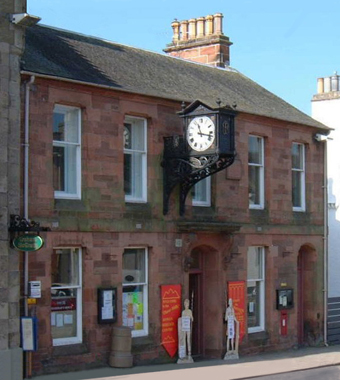

 |
Corn Exchange Market Square, Melrose, Roxburghshire |
||
|
The Ormiston Institute, pictured above, was built in 1882 at the bequest of Melrose
resident Charles Walter Ormiston. On the front of the building is a grand memorial
clock, erected by the grateful patients of physician and surgeon John Meikle.
The Roman Heritage Centre (also known as the Trimontium Museum) is located on the second floor of the Ormiston Institute. It highlights early Romano-native existence in this part of Scotland. Its particular concern is the Roman site which lies 1¼ miles (2 km) east beyond the village of Newstead, in the lee of the three Eildon Hills (hence Trimontium). The museum incorporates artifacts, models of the site, a blacksmith's workshop, a Roman kitchen and pottery and replica armor. Displays describe life in and around the Trimontium Fort between AD 80 and AD 185, through the use of descriptive panels, photographs and artist's impressions. Listed below are links to maps, descriptions and photos of other Ormiston places in the Borders region: |

|
Link to the history of
Teviotdale and Roxburghshire
The location of Ormiston House and the beginnings of the Ormiston family. |
||

|
Link to comments on the history of
Ormiston House
Ormiston House and actively working Ormiston Farm are popular destinations for student fieldtrips and visiting tour buses. |
||

|
Link to the history of
Haddingtonshire and East Lothian
Home to Ormiston Village, Ormiston Hall, the Ormiston Yew, and the ruins of Ormiston Castle |
||

|
Link to comments on the history of
Ormiston Village
Scotland's first planned village, built in 1735 and a model for the Agricultural Revolution. A center for linen production and coal mining. |
||

|
Link to comments on the history of
Ormiston Hall
Seat of the Ormiston Parish. Owned for centuries by the Cockburn family and sold by Lord Justice John Cockburn in 1747 to John Earl of Hopetoun. |
||

|
Link to comments on the history of the
Ormiston Yew
This tree may be 1000 years old! It has been the site of fiery rallies and of solemn rituals. Close to the ruins of Ormiston Hall. |
||

|
Link to comments on the history of
Ormiston Castle
The castle is gone now and only grass-covered mounds remain. See a painting and a description of the castle by a talented artist, historian, and educator. |
||

|
Ancient inhabitants on
Ormiston Hill and Ormiston Farm in Fife
How is the name Ormiston related to Macbeth and Macduff? |

|
Return to ORMISTON HOME page |
